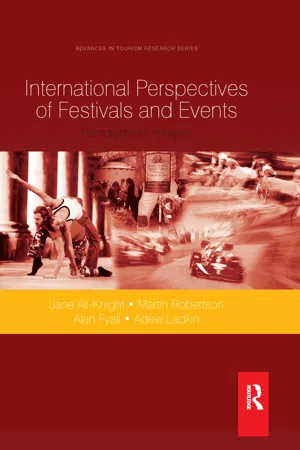Part 1Destination, Image and Development
Martin Robertson
This first section offers five chapters each addressing the role of festivals in forming or at least playing a significant role in the definition of destination place. The title of this section, “Destination, Image and Development” reflects the different areas covered by the respective authors.
In their individual chapters Smith and Saad address an important but yet less documented area of investigation: how do large events affect the viability, visibility and opportunity for developing areas outside the central hub of event activity? In Chapter 1 Smith assesses the function, actual and possible, for major events in promoting areas on the fringe of a city. The objectives of the research undertaken by Smith are threefold: first, to identify how peripheral urban areas can maximise the promotional prospect of major events; second, to evaluate the relationship between the media and these areas and third, an assessment of the potential role of major events as mechanism for promoting and improving the image of peripheral areas. Mediating on the interrelationship of the 2007 Tour de France starting stage, Grand Depart, London, and the area of Deptford in South East London – a 19th century Dockyard town, which has gone through a prolonged period of downturn in the latter half of the 20th century, the chapter highlights the challenges of attempting multiple (spatial) ownerships of major events. Through a combination of secondary research, semi-structured interviews with key stakeholders and review of related media materials, the work evaluates the success in accumulating promotional leverage and opportunities for co-branding association.
Chapter 2 by Saad inquires as to the degree to which the coastal towns of Weymouth and Portland have gained or are managing development in order to gain from Weymouth's hosting of the sailing events for the 2012 Olympics Games. In first evaluating the position of a once very well-renowned coastal resort in the south east of England which has embarked on a series of developments to regain prominence, Saad reflects on the ambiguity of the image and market position of Weymouth. Building on an extensive literature review of the growth, form and function of the events as town and city development tools, Saad assesses the current event product range, economic state, political readiness as well as the results of a questionnaire distributed to 1000 members of the resident population in Weymouth and Portland to determine desired as well suggest prudent use of the opportunity afforded by their hosting of the Games.
The issues surrounding a destination and the effective and long-term strategic use of its event are inspected again in Chapter 3 by Liburd. Consideration is given to the successes, opportunities and limitations of events as drivers of destination themes which can serve to unify tourism providers. Here the appraisal is borne of reflection on existing reports, application of surveys, analysis of printed and electronic media as well as interviews related to Denmark's Hans Christian Andersen bicentenary event – the first occurrence of such a year long themed event. By comparing the original objectives of the event with the outcomes, an evaluation is made of the event product development affect and, most particularly, how effective the event was in animating international markets. Liburd's analysis espouses the positive results of collaboration between the tourist board, VisitDenmark, some DMOs and the principle public relation organisation in making the visitor experience successful. However Liburd also laments that the potential for more tactical collaborative thematic product development was undone by a continuation of a long-standing animosity between the culture and tourism sectors in Copenhagen. This resulted in many elements of the event not resonating with the predominant expectation by international visitors of experiences related to the Danish fairy tale author. The chapter concludes that there are still significant challenges in creating the links between these sectors to ensure long-term success.
In Chapter 4, Foley, McPherson and McGillivray, in their analysis of Singapore, query attempts to change the image of a place through events. This stimulating work utilises a mixed methods case study approach. From interviews regards events and festival policy in Singapore with leaders of statutory and non-statutory bodies affiliated with, respectively, tourism, sport, culture and enterprise for the country and city the findings have then been reviewed through analysis of strategy documentation. This approach first provides a critical synopsis of the political and cultural context in which Singapore attempts a brand extension, wherein its image foremost as a business (event) destination attempts transmutation into one in which Singapore is a “vibrant cultural hub”. The work then goes on to gauge the mixture of traditional cultural events and manufactured sporting events of international standing as elements of global “place” competition. The work concludes that the brand redefinition sought through events is inseparable from the overarching mixture of tradition and modernity that Singapore has long sought in its notion of Singapore as New Asia. The conclusion also warns that the aspiration to be the Event and Entertainment Capital of Asia may be too reliant on demonstrations of image and not enough on logical involvement.
One theme common to all these chapters is the need for collaborative endeavour to ensure longterm success for destinations that host major events. In this sections” final chapter, Chapter 5, Byeon addresses the limited extent to which stakeholders were included in the co-hosted 2002 FIFA World Cup. A longitudinal investigation of the role of the Korean hotel industry in the run up to, during...
